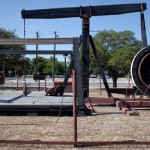As Prices Fall, Finding a Sweet Spot for Oil in Texas

Dave Fehling/StateImpact Texas
Deep in the Heart of Texas Oil: an Italian restaurant has pulse of industry
Barbie Lomonte works in a part of Houston that has one of its biggest concentrations of oil and gas companies. She knows a lot about the industry and what the price for a barrel of oil means to it.
“Business has been wonderful, oil and gas are doing well and I have nothing to complain about,” said Lamonte as her employees bustled around her, filling orders.
She herself isn’t an oil trader nor does her company do any drilling. But it does use lots of oil. But of the olive variety, not Texas tea. She owns Lomonte’s Italian Restaurant.
“We’re right in the middle of the Energy Corridor,” said Lomonte.
The Energy Corridor is what the locals call a strip along Interstate 10 that runs west out of Houston. From Lomonte’s restaurant, you can drive less than two miles and pass the headquarters of ConocoPhillips, BP America and CITGO. At lunch time, a shuttle bus brings geologists, oil engineers, and accountants by the dozens to Lomonte’s and several other eateries clustered under big live oaks.
Lomonte has run the restaurant for over two decades and has shared the roller-coaster ride that is the oil business in Texas.
“The worse was, unfortunately, the spill in the Gulf. That was painful for all of us,” Lomonte said of the Deepwater Horizon disaster in 2010.
Over the years, Lomonte said she has seen the demeanor of her clients dim and brighten with the price per barrel: hunkering down and spending less on wine when oil prices fell and splurging when prices reached where they’ve been this year: around $100 a barrel.
“When it’s good, they’re celebrating more,” said Lomonte.
The ‘Goldilocks’ Price
Her customers aren’t the only ones in Texas who are happy with what oil is now selling for.
“Right now, we seem to be in a sweet spot,” said James LeBas who advises the Texas Oil & Gas Association.
LeBas used to work for the State of Texas, estimating how much revenue would come from taxes, including those from oil and gas drilling.
“Employment is rising, production is rising, drilling is rising. State and local governments are taking in a lot of additional tax revenues that were unanticipated. And as long as we stay in this band where we are today, it seems to be healthy for everybody,” said LeBas.
Some call it the Goldilock’s price for oil: not too low that it discourages production, not too high that it hurts demand.
For Texas, More Tax Revenue
A few decades ago, the state got roughly a quarter of all tax revenue from oil and gas production. Today, it gets only about half that, said Dale Craymer, another former revenue estimator for Texas and now president of the Texas Taxpayers and Research Association.
“But still, no question, it’s a critically important source of revenue to the state,” Craymer told StateImpact Texas.
“Texas state finances tend to rise and fall with the health of the oil and gas industry,” said Craymer. And right now, those finances are beating expectations.
“(The state’s) official budget projections are based on a little less than $80 a barrel. And we’re running close to $100 a barrel now so we are running well in excess of our official forecast,” said Craymer.
How Low is Too Low?
That relatively high price has helped support the current drilling boom, much of which relies on hydraulic fracturing or “fracking,” as it’s called. (The highest price for West Texas Intermediate crude was $145 in July 2008, but by September of that year it dropped back below $100.)
How far would prices have to fall to slow it down? James LeBas, the other former state revenue estimator, says it’s not that much further: “If (energy companies) believe that we’re going to be in the $80 range, then they will probably continue to explore and develop at the current level.”
But if the price falls below that magic $80 sweet spot?
“Each company will make its own decision but the lower the price goes, more of them will hit their magic number where they will decide to curtail exploration and production,” said LeBas.
Many of the companies operating in the hottest spots for drilling in Texas—the Permian Basin in West Texas, the Barnett Shale in North Texas, and the Eagle Ford shale in South Texas—might be able to do business as usual even if prices dropped into the $70 range, according to Jeff Dietert, co-head of research at Simmons & Company, a Houston-based investment bank for the energy industry.
“The cost of a well is going down, the number of days to drill a well is declining as operators get more efficient with these new technologies,” Dietert told StateImpact Texas.
Oil prices are affected by the overall world economy, by production decisions made by cartels and by conflicts in foreign, oil-producing countries. In recent days, the trend has been downward.
“What’s happened is that we’re over-supplying the market, inventories are building. So that’s recently put some pressure on oil prices and we’re seeing them come down,” said Dietert.
Whether prices will continue to fall is anyone’s guess. And no one knows how long the Goldilocks price that has been so good for Texas will last.

